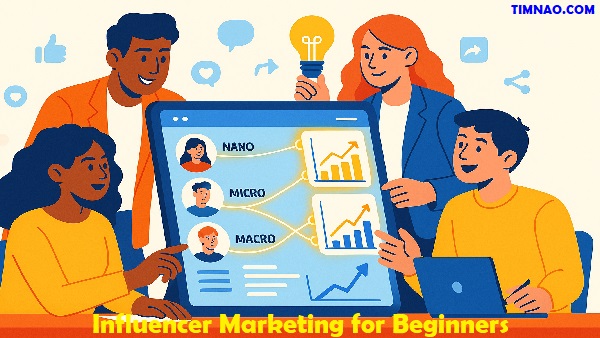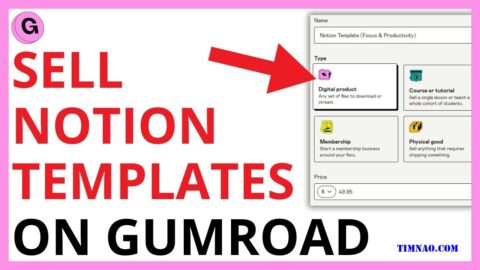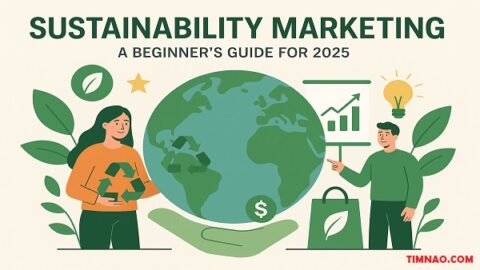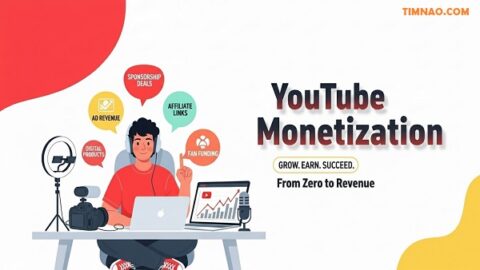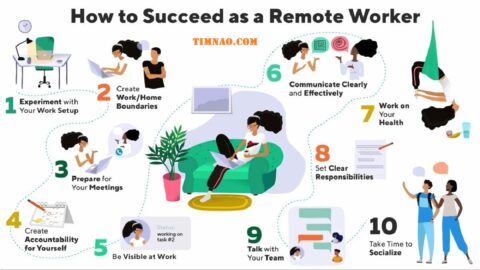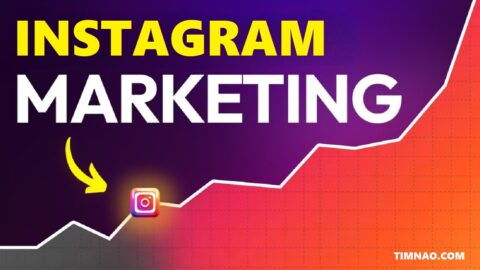The Shocking Truth About Influencer Marketing in 2025: A Beginner’s Guide to Powerful Brand Growth 🚀
Influencer marketing for beginners is no longer a trend—it’s a powerful strategy transforming how brands connect with audiences, build trust, and drive real sales. In 2025, whether you’re a startup founder, solopreneur, or digital creator, partnering with the right influencers can help your brand rise above the noise without burning through your budget.
But here’s the truth: success doesn’t come from blindly paying people with large followings. It comes from understanding how to create authentic, strategic, and measurable collaborations that resonate with real people. And that’s exactly what this guide will help you do.
In this comprehensive article, we break down everything you need to know about launching and scaling a successful influencer campaign—even if you’re starting from scratch. From choosing the right influencers to tracking ROI and future-proofing your strategy, it’s all here.
Let’s dive into the essentials that will help you build powerful partnerships and unlock growth in today’s influencer-driven landscape. 👇
📚 Table of Contents
- 🎯 Why Influencer Marketing Works for Beginners
- 📈 Key Trends Shaping Influencer Marketing in 2025
- 👤 Types of Influencers You Can Work With
- 🎯 Setting Goals That Actually Deliver Results
- 🔍 Finding the Right Influencers for Your Brand
- 🛠️ Crafting a Smart Influencer Strategy from Scratch
- 🤝 How to Build Winning Partnerships with Influencers
- 🧪 Different Campaign Types That Work (with Examples)
- 📊 Measuring Success: Key Metrics That Matter
- ♻️ How to Repurpose Influencer Content for Growth
- 🚧 Common Pitfalls to Avoid in Influencer Marketing
- 🔮 What’s Next: The Future of Influencer Marketing
- ✅ Your Beginner Action Plan (Checklist Included)
🎯 Why Influencer Marketing Works for Beginners
Let’s face it—traditional ads just aren’t cutting it anymore. People scroll past them or use ad blockers. But when someone you trust says, “Hey, this product works,” you pay attention.
That’s the secret sauce of influencer marketing for beginners. It’s not about hiring celebrities with millions of followers. It’s about partnering with real people who’ve built trust with a specific audience—whether it’s 1,000 or 100,000 followers.
Why is this such a game-changer for beginners?
- Authenticity wins. Influencers already have the trust you’re trying to build.
- It’s affordable. You can start small and scale up.
- It drives real results. We’re talking sales, not just likes.
In 2025, influencer marketing is more than a buzzword—it’s the go-to strategy for businesses looking to grow without burning through their budget.
📈 Key Trends Shaping Influencer Marketing in 2025
The influencer space is evolving fast. To stay ahead, beginners need to keep an eye on what’s changing.
Here’s what’s hot in 2025:
🔍 Micro over Mega
Brands are moving away from mega-influencers and focusing on micro-influencers (10k–100k followers) who have better engagement and niche appeal.
🎥 Short-Form Video Dominates
Thanks to TikTok, Instagram Reels, and YouTube Shorts, video content is king. Static posts are being replaced by authentic, snackable videos.
🤝 Long-Term Partnerships
Instead of one-off promos, brands are building ongoing relationships with influencers to create consistent, trust-driven messaging.
💰 Performance-Based Deals
Forget flat fees—many brands now pay based on sales or leads generated. It’s a win-win and ensures everyone stays invested.
🤖 AI-Powered Influencer Discovery
AI tools now help brands match with influencers based on audience behavior, authenticity, and even tone of voice—taking the guesswork out of the process.
👤 Types of Influencers You Can Work With
Not all influencers are created equal. Here’s a quick breakdown of the types you can choose from:
| Type | Follower Count | Best For |
|---|---|---|
| Nano Influencers | 1K–10K | Community-driven, hyper niche |
| Micro Influencers | 10K–100K | Best balance of reach + trust |
| Macro Influencers | 100K–1M | Big reach, professional content |
| Mega Influencers | 1M+ | Mass exposure, celebrity status |
Tip for beginners: Start with micro or nano influencers. They’re affordable, engaged, and often open to collaboration.
🎯 Setting Goals That Actually Deliver Results
Before reaching out to influencers, clarify your goals.
Using the SMART framework (Specific, Measurable, Achievable, Relevant, Time-bound), set goals like:
- Grow Instagram followers by 25% in 3 months.
- Increase website traffic by 1,000 visits per month.
- Generate 50 sales via influencer promo code in 30 days.
Also, align these goals with business outcomes: Do you want brand awareness, sales, or lead generation?
Each objective may require a different influencer type, content format, and call-to-action (CTA).
🔍 Finding the Right Influencers for Your Brand
How do you find influencers that actually move the needle?
Start with Your Audience
Ask: Who does your ideal customer follow on Instagram, TikTok, or YouTube?
Use These Tools:
- Heepsy – Search by niche, engagement, and location
- Upfluence – Great for eCommerce and CRM integration
- BuzzSumo – Identify content creators and trending topics
Look for These Green Flags:
- Consistent engagement (not just high follower count)
- Authentic content (not overly sponsored)
- Shared values (do they believe in your brand’s mission?)
So where do you find these perfect partners?
- Hashtag and Keyword Research: Search for relevant hashtags and keywords on platforms like Instagram, TikTok, and YouTube. Look for creators who are consistently producing high-quality content in your niche.
- Analyze Your Competitors: See which influencers your competitors are working with. This can give you a great starting point and reveal creators who are already effective in your industry.
- Use Influencer Marketing Platforms: Tools like Upfluence, Aspire, and GRIN are designed to help you discover and vet influencers. They provide detailed analytics on audience demographics, engagement rates, and even detect fake followers, saving you time and money.
- Check for Authenticity: Don’t be fooled by vanity metrics. Use a tool like HypeAuditor to check for fake followers and engagement. Look at the comment section—are the comments genuine conversations or generic spam? An authentic influencer has an active, real community.
🛠️ Crafting a Smart Influencer Strategy from Scratch
You don’t need an agency to build a smart strategy. Here’s a beginner-friendly blueprint:
- Define your campaign objective (awareness, sales, leads)
- Choose your influencer type (nano, micro, etc.)
- Outline deliverables (post types, platforms, timelines)
- Set your budget
- Create a content brief (visual tone, hashtags, CTA)
- Plan your launch schedule
Tools like Notion or Trello help organize campaigns and keep everything on track.
With your goals set and potential influencers identified, it’s time to build your campaign strategy. This involves setting a budget, crafting a compelling outreach message, and understanding the legal rules of the road.
Budgeting for Your Campaign
Your budget will depend on your goals and the type of influencers you work with. Compensation isn’t one-size-fits-all and can include:
- Pay-Per-Post: A flat fee for a specific piece of content. Rates vary wildly, from under $100 for a nano-influencer to tens of thousands for a macro-influencer.
- Product Seeding: Gifting products in exchange for a review or post. This is a great, low-cost option when working with nano or micro-influencers who genuinely love your brand.
- Affiliate Marketing: Giving influencers a unique discount code or trackable link and paying them a commission on every sale they generate. This is a performance-based model that directly ties your spend to your goal to drive sales.
When starting out, a mix of product seeding and affiliate partnerships is a budget-friendly and effective approach. Remember to also account for the costs of shipping products and any platform fees.
The Perfect Pitch: Influencer Outreach
First impressions matter. When you reach out to an influencer, a generic, copy-pasted message will likely be ignored. Personalization is key.
Your outreach email or direct message should:
- Address them by name.
- Mention something specific you love about their content. Show you’ve actually done your research.
- Briefly introduce your brand and explain why you think a partnership would be a great fit for their audience.
- Clearly state what you’re offering. Be upfront about compensation and what you hope to achieve together.
- Keep it concise and professional.
Staying Compliant: The FTC Guidelines
Transparency is non-negotiable. The Federal Trade Commission (FTC) has strict guidelines requiring influencers to clearly disclose when their content is sponsored. This is crucial for maintaining trust with the audience and avoiding legal trouble.
The disclosure must be clear and conspicuous. This means using unambiguous language like #ad, #sponsored, or #BrandPartner. It should be placed where it’s easy to see, not buried in a long list of hashtags. As a brand, it’s your responsibility to ensure your influencer partners follow these rules.
🤝 How to Build Winning Partnerships with Influencers
The magic of influencer marketing doesn’t just lie in the outreach—it’s in the relationship.
A successful influencer partnership is more than just a transaction; it’s a collaboration. Here’s how to get it right:
1. Personalize Your Outreach
Ditch the copy-paste DMs. Influencers get dozens of pitches weekly. If you want to stand out:
- Mention why you love their content.
- Explain why they’re a great fit for your brand.
- Keep it short, friendly, and authentic.
Example message:
“Hey [Name], I’ve been loving your content on [Platform], especially your recent [post/video about topic]. We’re launching a new [ product / service ] that aligns with your style, and I’d love to explore a potential collaboration. Would you be open to a chat?”
2. Be Clear About Expectations
Before you seal the deal, outline:
- Deliverables: Posts, stories, videos, links.
- Deadlines: When to post and how often.
- Compensation: Flat fee, product, affiliate commission, or hybrid.
- Creative freedom: Let influencers bring their voice to your brand.
3. Provide the Tools for Success
Make your influencers feel like part of your team:
- Send them your brand guidelines.
- Offer talking points (not scripts).
- Share images, hashtags, and product info.
4. Think Long-Term
One-off promotions can work, but long-term collaborations build familiarity and trust with their audience.
Consider brand ambassadorships where influencers create content monthly or quarterly, helping establish consistent branding.
🧪 Different Campaign Types That Work (with Examples)
Influencer marketing isn’t one-size-fits-all. Choose your campaign type based on your goals, budget, and product. Here are the most effective options for beginners:
🎁 1. Sponsored Posts
Goal: Reach new audiences and generate buzz
Best for: Product launches, awareness
An influencer shares a branded image, video, or story with a direct call-to-action. Keep it simple but impactful.
💡 Example: A skincare influencer does a 30-second morning routine on TikTok featuring your cleanser.
🎉 2. Giveaways
Goal: Drive engagement and follower growth
Best for: Rapid exposure
Partner with an influencer to give away your product. Requirements usually include following your brand, liking the post, and tagging friends.
💡 Example: “Win my favorite skincare bundle! Follow @yourbrand, like this post, and tag 3 friends. Winner announced Friday!”
👑 3. Brand Ambassadorships
Goal: Build long-term brand equity
Best for: Products with repeat use
Choose 3–5 influencers to represent your brand over several months. They become recognizable faces associated with your product.
💡 Example: A fitness influencer posts monthly gym routines using your resistance bands.
💵 4. Affiliate Marketing
Goal: Increase trackable sales
Best for: E-commerce and low-CAC models
Give influencers custom discount codes or affiliate links. They earn a percentage per sale, giving them skin in the game.
💡 Example: “Use code JENFIT10 to get 10% off! I earn a small commission.”
📺 5. Live Events or Takeovers
Goal: Boost engagement and excitement
Best for: Launches, behind-the-scenes, Q&A
Let influencers go live on your brand’s account or co-host a product reveal. This brings direct interaction with your audience.
💡 Example: An influencer goes live to unbox your product and answer questions live with your team.
📊 Measuring Success: Key Metrics That Matter
If you don’t measure it, you can’t improve it. Here are the most important metrics beginners should track:
1. 💬 Engagement
- Likes, comments, shares, saves
- Track how the audience is reacting to the content.
- Use tools like Later or Sprout Social to simplify tracking.
💡 Benchmark: Aim for 2–5% engagement rate for micro-influencers.
2. 🧭 Website Traffic
- Use UTM links to monitor traffic from influencer campaigns in Google Analytics.
- See which influencers are driving clicks to your site.
💡 Pro Tip: Use Bitly or Pretty Links to create custom short URLs.
3. 💰 Conversions and Sales
Track how many actual purchases came from the influencer. Use:
💡 Goal: Track ROI and compare which influencer drives more qualified leads.
4. 📈 Reach and Impressions
- How many people saw your content?
- Platforms like Instagram and TikTok provide these stats natively.
💡 Warning: Reach doesn’t always equal results. Engagement and conversions matter more.
♻️ How to Repurpose Influencer Content for Growth
The beauty of influencer content? You don’t have to reinvent the wheel.
Here’s how to reuse influencer posts:
- Share on your own social media.
– Tag the influencer and include a short CTA. - Feature on your website.
– Add reviews, testimonials, or UGC on product pages. - Use in email marketing.
– Social proof increases open and click rates. - Turn into ads.
– With permission, use influencer videos for paid Facebook or TikTok ads.
💡 Pro Tip: Ask for usage rights up front in your agreement to avoid legal issues.
🚧 Common Pitfalls to Avoid in Influencer Marketing
While influencer marketing offers incredible upside, beginners often stumble into traps that can cost time, money, and brand trust. Here’s how to steer clear of the most common mistakes.
❌ 1. Focusing Only on Follower Count
Don’t be dazzled by big numbers. A micro-influencer with 15k engaged followers often outperforms a celebrity with 1 million disengaged ones.
What to do instead: Prioritize engagement rate, niche relevance, and authentic content over sheer follower size.
❌ 2. Ignoring Audience Alignment
It doesn’t matter how great the influencer is—if their followers don’t match your ideal customer, your campaign will flop.
What to do instead: Study the influencer’s audience demographics using tools like HypeAuditor or by asking for media kits before collaboration.
❌ 3. Not Setting Clear Expectations
Vague partnerships lead to misaligned content and disappointment on both sides.
What to do instead: Use contracts or briefs that outline deliverables, deadlines, and goals. Include content usage rights, disclosure requirements, and payment terms.
❌ 4. Underestimating FTC Compliance
Failing to disclose sponsorships can lead to legal trouble and audience distrust.
What to do instead: Require influencers to clearly label posts using #ad, #sponsored, or platform-specific disclosure tools.
❌ 5. Not Measuring ROI
Guessing your campaign’s success isn’t a strategy.
What to do instead: Track clicks, conversions, engagement, and cost per acquisition (CPA). Continuously refine based on data.
🔮 What’s Next: The Future of Influencer Marketing
Influencer marketing in 2025 is already lightyears ahead of where it started. So what’s coming next? Here’s what beginners should watch closely.
🧠 1. Rise of AI and Virtual Influencers
AI-generated influencers like Lil Miquela are gaining serious traction. These digital personalities offer brands full control, consistency, and creative freedom—without human error.
What it means for you: Keep an eye on CGI creators and tools like Synthesia for budget-friendly content creation.
🤏 2. Micro-Communities Will Rule
Trust is trending hyper-local. Expect brands to shift from wide-reaching influencers to tight-knit communities where trust is high.
What it means for you: Focus on nano and micro influencers who deeply connect with niche audiences.
🌐 3. Multi-Platform Influence Is the Norm
No more “just Instagram.” Successful influencers now build followings across YouTube, TikTok, LinkedIn, Substack, and beyond.
What it means for you: Choose influencers who have multi-channel presence and adapt your campaign for platform-specific formats.
📉 4. Pay-for-Performance Will Dominate
Brands are getting smarter—and expect measurable results. Flat fees are fading, and performance-based deals (affiliate commissions, sales targets) are becoming the new normal.
What it means for you: Structure your partnerships with a performance-first mindset to minimize risk and maximize ROI.
✅ Your Beginner Action Plan (Checklist Included)
You’ve made it this far—now it’s time to put knowledge into action.
Use this simplified step-by-step checklist to launch your first influencer marketing campaign with confidence.
🎯 Step 1: Set Your Campaign Goal
- Brand awareness
- Lead generation
- Sales and conversions
🧠 Step 2: Define Your Ideal Influencer
- Niche and content style
- Engagement rate (2–5% minimum)
- Aligned values and authentic tone
🔍 Step 3: Find and Vet Influencers
- Use discovery tools (Heepsy, Upfluence, BuzzSumo)
- Review past collaborations
- Ask for media kits and audience insights
📨 Step 4: Reach Out Strategically
- Send personalized DMs or emails
- Offer mutual value
- Be transparent about deliverables and timelines
💬 Step 5: Formalize the Collaboration
- Use a written agreement or contract
- Define content guidelines, payment, usage rights
- Ensure FTC compliance with disclosure instructions
📈 Step 6: Launch and Monitor
- Track content performance (likes, saves, comments)
- Monitor traffic and conversions with UTM links
- Collect content for repurposing
📊 Step 7: Measure and Optimize
- Compare campaign results to original goals
- Identify top-performing influencers
- Adjust future strategy based on real data
Final Thoughts 💡
Influencer marketing isn’t just for big brands with massive budgets. In fact, it’s often more effective and affordable for beginners—if you know how to approach it the right way.
By starting small, staying authentic, and focusing on real engagement over vanity metrics, your brand can tap into the power of influencers to grow faster than ever.
This guide has equipped you with the tools, trends, and strategies to build powerful partnerships, avoid rookie mistakes, and create campaigns that actually convert.
Now, it’s your turn. Ready to launch your first influencer marketing campaign?
Reference video:

